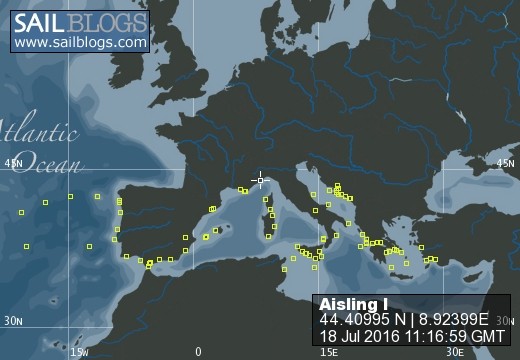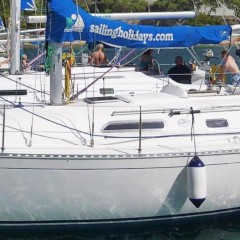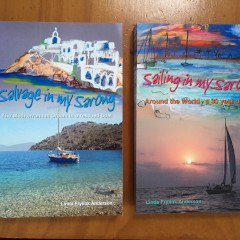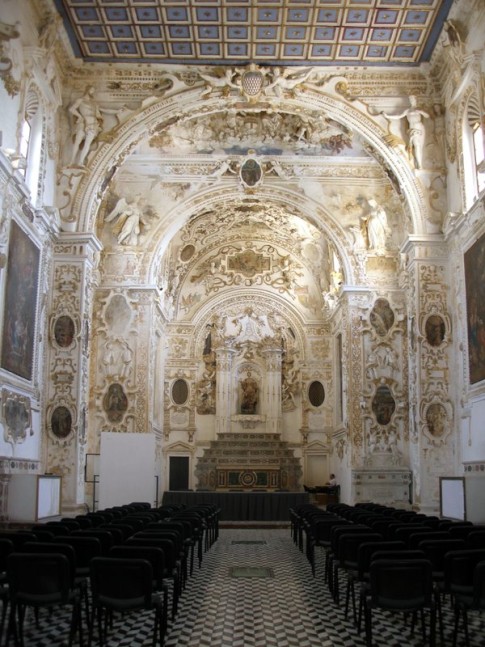

Aisling I
18 July 2016 | Genoa
11 July 2016 | Genoa Italy
04 July 2016 | Genoa
02 July 2016 | Genoa
25 June 2016 | Porto Azzurro Elba
11 April 2016 | Marina di Ragusa
21 March 2016 | Halifax
01 March 2016
14 January 2016
30 September 2015
25 September 2015 | Crotone Italy
18 September 2015 | Erikoussa
10 September 2015 | Preveza
10 September 2015 | Preveza
24 July 2015 | Preveza
20 July 2015 | Varko Bay
13 July 2015 | Vlicho Bay
09 July 2015
03 July 2015 | Preveza Greece
21 June 2015
The Palazzi of Via Garibaldi
18 July 2016 | Genoa
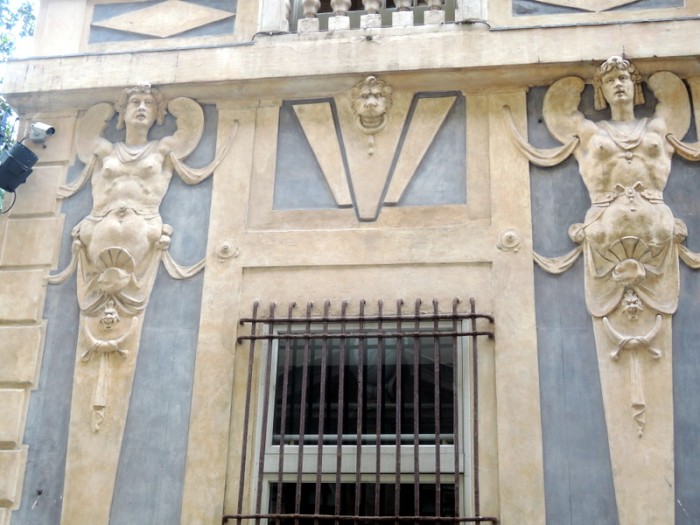
Via Garabaldi began its life as the Strada Maggiore, one of the Strade Nuove (new streets) that were created as part of an urban planning project in 16th century Genoa. The new streets were wider than the medieval streets, and here the wealthiest citizens built their elaborate Renaissance and Baroque palazzi (palaces). During the days of the powerful admiral Andrea Doria, the palazzi were used to host visiting dignitaries, based on a list that categorized the palaces according to the importance of the dignitaries that could be entertained there. It was a bit like the star system for hotels, but the guests stayed free of charge. The palaces on the list became known as the Palazzi dei Rolli (palaces of the roll). The area of Genova that houses forty two of the palaces now has UNESCO World Heritage designation.
Although the Italian word "palazzo" can apply to a broad range of dwellings, these were palaces in the true sense of the word. Definitely 5 stars! Today, many of the palaces are open to the public as museums. Others are in use as places of business (mainly banks because, as Rick says, who but the banks could afford places like these!) The palaces typically have three or four stories, grand staircases, beautiful courtyards and gardens, frescoed ceilings and elaborate facades. It is important to note that in those days, each story was from 20-30' high.
On a quiet Saturday afternoon, we took a walk down Via Garabaldi. We gaped at the elaborate facades and courtyards, to a background of beautiful singing provided by a street performer. It was difficult to capture in photos, but we tried.




I hate to admit it, but one of our favourite places on Via Garibaldi was a decorating store! The contrast between old and new somehow worked.


Three of the palaces on Via Garibaldi are now museums, and a single ticket gives access to the Palazzo Rosso, Palazzo Bianco and Piazzo Doria Tursi (now the Municipio, or town hall). The Palazzo Bianco and Palazzo Rosso house room upon room of art, including works by Van Dyck, Rubens, Strozzi, Caravaggio and the Genovese artist known as Il Grechetto. Caravaggio's Ecce Homo was one we'd been waiting to see:

In the Palazzo Tursi we saw Paganini's violin, which he bequeathed to his home town in his will.

And it was in the Palazzo Tursi that we also saw the masterpiece that literally made us gasp: Canova's Maddalena penitente.


It may be worth a trip to Genoa just to see it. But there are a lot of reasons to come to Genoa, and we'll tell you more later. Next, a trip to the cemetery.
Although the Italian word "palazzo" can apply to a broad range of dwellings, these were palaces in the true sense of the word. Definitely 5 stars! Today, many of the palaces are open to the public as museums. Others are in use as places of business (mainly banks because, as Rick says, who but the banks could afford places like these!) The palaces typically have three or four stories, grand staircases, beautiful courtyards and gardens, frescoed ceilings and elaborate facades. It is important to note that in those days, each story was from 20-30' high.
On a quiet Saturday afternoon, we took a walk down Via Garabaldi. We gaped at the elaborate facades and courtyards, to a background of beautiful singing provided by a street performer. It was difficult to capture in photos, but we tried.
I hate to admit it, but one of our favourite places on Via Garibaldi was a decorating store! The contrast between old and new somehow worked.
Three of the palaces on Via Garibaldi are now museums, and a single ticket gives access to the Palazzo Rosso, Palazzo Bianco and Piazzo Doria Tursi (now the Municipio, or town hall). The Palazzo Bianco and Palazzo Rosso house room upon room of art, including works by Van Dyck, Rubens, Strozzi, Caravaggio and the Genovese artist known as Il Grechetto. Caravaggio's Ecce Homo was one we'd been waiting to see:
In the Palazzo Tursi we saw Paganini's violin, which he bequeathed to his home town in his will.
And it was in the Palazzo Tursi that we also saw the masterpiece that literally made us gasp: Canova's Maddalena penitente.
It may be worth a trip to Genoa just to see it. But there are a lot of reasons to come to Genoa, and we'll tell you more later. Next, a trip to the cemetery.
Genoa: La Superba!
11 July 2016 | Genoa Italy
Bonnie
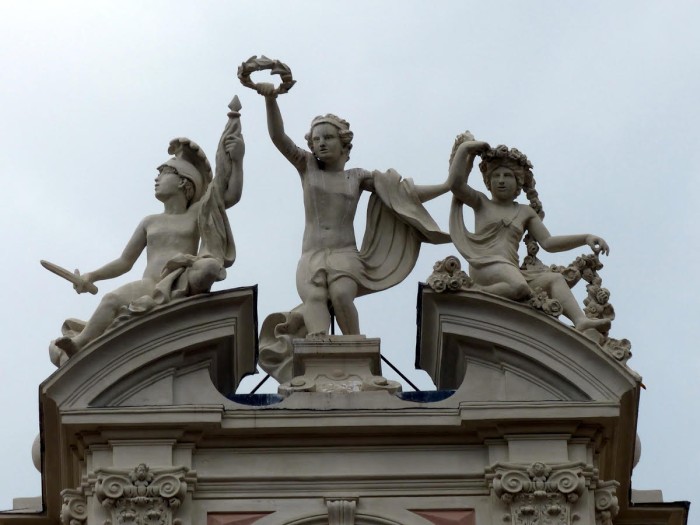
For several reasons, Genoa (Genova in Italian) seems a fitting choice as Aisling's final port in the Mediterranean. First, Genoa was the birthplace of the great explorer Christopher Columbus, who "discovered" America. It's true that he thought he was in Asia when he got there, but you have to give him bonus points for the fact that he managed to sail back home with two out of three of his ships. He also returned to the Caribbean three additional times, albeit never realizing that he had discovered two new continents. Another interesting fact about Genoa is that the first denim-like fabric was developed here, and blue jeans probably took their name from this city. This may be of little interest to most of you, but is of great significance to the skipper of this boat, who earned his living in the world of jeans and fashion for more years than he likes to admit. We've also seen Genovese forts scattered in numerous locations throughout the Mediterranean, evidence of the time when Genoa was known as "La Superba" and was one of the most powerful Italian city-states. In spite of all this, Genoa had never been on our list of must-see cities in Italy. It quickly became obvious that it should have been.
I should mention that we'd actually visited Genoa briefly last year. We drove through with our friends Ni and Krissy on our way back to Italy from a boat show in France. We even stopped for a pizza at the Pizzeria Del Ponte (highly recommended). But although we'd stayed in Liguria for several days, we'd focused our attention on Santa Margherita, Portofino and Portovenere, then made our way to Tuscany. It's too bad that we didn't write a blog about that trip, but you can click here if you'd like to see some photos of it in our gallery.
Photos of Liguria and Tuscany 2015
Rick says he doubts he'll ever find a place in Italy that he doesn't like. True, but some Italian cities are nicer than others. Genoa seems to get a bad rap in a lot of guidebooks and online articles. They sometimes use articles like "gritty" to describe the city, and then qualify it by saying that if you dig deeper you can find wonderful things to see. But we kind of like that the small alleyways of the historic centre have not been gentrified like those of towns where tourism is a major focus. Genoa is a genuine, living city, with an abundance of history, architecture and masterpieces reflecting the staggering wealth of its former citizens. There is so much to see that it's hard to know where to begin.
Let's begin in the port, at the Marina Molo Vecchio, where we tied up our lines at 6 a.m. on the morning of our arrival, with the help of a friendly German cruiser who happened to be out walking his dog. From Aisling's deck, we could see the famous Lanterna, the third oldest lighthouse in the world, and the 5th tallest. Interesting that the name of the ship that appears beneath it in the picture is "La Superba".

We are in the heart of the old port, which has been completely modernized with numerous tourist attractions. These include a large aquarium, a biosphere housing a small ecosystem, an old galleon and a scenic elevator that sits inside a weird looking spidery contraption that looks as though it is made of masts.

On the opposite side of the port, an old cotton warehouse houses a children's amusement centre as well as a nice choice of restaurants and bars. In front of the warehouse, the dock is lined with superyachts. Diego, a staff member at Marina Molo Vecchio, tells us that one yacht belongs to Steven Speilberg but the largest, Serena, belongs to a "Mr. X" ( a Russian vodka baron, we later learn). We are across the water from the superyachts but near the "Wallys", which are mere toys compared to the immense boats of the enormously rich. In fact, the only part of the port that doesn't seem to have been modernized is the building that houses the marina's shower and toilets, which are dismal and dirty.
The real treasures are in the heart of the historic centre, with its palazzos, museums and churches. And the restaurants, of course. Genoa must be a contender for a "best food in Italy" prize: high praise, as you can appreciate. This is the home of focaccia, which you can buy plain or topped with onions, cheese, olives, peppers, or numerous other delicacies. Liguria is also the birthplace of pesto, which is so good here that it scarcely resembles the stuff we buy in jars at home. Naturally, our first outing was to go out to lunch, at the Trattoria Rosmarino near the Piazza Ferrari. The lunch was a nice experience, but the better meals were yet to come.

On our way back to the port, we walked through the Piazzo San Lorenzo and had our first glimpse of the beautiful Gothic cathedral, with its black and white marble striping. The two lions, sculpted by Carlo Rubatto, are exceptional.

If we run out of things to do, we can always watch "the Greens" from our cockpit. Directly across from us is a section of dock where three boats with lime-green paint are docked: a sailboat, a motor boat and a weird looking houseboat. All the boxes on the dock are painted lime green. The older man, whom we assume is the owner, wears lime green shorts. Rick has spent a considerable amount of time trying to figure out what the Greens are doing over there. Running a sailing school? Taking people out for day sails? Or maybe this is just the Green family compound. I suppose we could ask someone at the office, but that would spoil the fun.
During the journey from Sicily, I'd looked forward to our arrival in Genoa with great anticipation, but mainly because I couldn't wait to get the boat cleaned up. During our first few days in Genoa, we did very little sightseeing, instead working to clean up the mud from the Sicilian scirocco (sirocco) that had deposited mud on our sails and throughout every crevice above decks on the boat. Since we'd left Marina di Ragusa in a hurry while the effects of the sirocco were still unfolding, we hadn't been able to clean Aisling properly. To make matters worse, we had picked up a lot of black volcanic dust from either Mt. Etna or Stromboli, or perhaps both. So after we arrived here, sails had to be washed and dried, then removed, folded and stored. The sheets, halyards and other lines had to be washed. Thankfully, most of the dirt seemed to have blown off the standing rigging, but the decks, cockpit and all the fittings had to be cleaned. The stainless steel was also a sad sight, having suffered the indignities not only of the sirocco but from the salt crystals deposited by 600 miles of upwind sailing. Thankfully, we have access to unlimited water here.
We finally have things looking almost normal. Although we know that some jobs will have to be done again on the other side of the Atlantic, we want Aisling to look her best while she is here at the dock. And she could be here for a long time. Having first cancelled the boat to Sydney at the end of June, Sevenstars has now cancelled their mid-July shipment from Genoa to Pennsylvania. We've been given a new, supposedly "firm" booking for the end of July. But the small print said "agw, wp", meaning "all going well, weather permitting". That doesn't sound quite as firm as we'd like. Here's hoping it works out. In the meantime, this is a very nice place to wait. Next up, the palazzos of Genoa. They're unbelievable!
I should mention that we'd actually visited Genoa briefly last year. We drove through with our friends Ni and Krissy on our way back to Italy from a boat show in France. We even stopped for a pizza at the Pizzeria Del Ponte (highly recommended). But although we'd stayed in Liguria for several days, we'd focused our attention on Santa Margherita, Portofino and Portovenere, then made our way to Tuscany. It's too bad that we didn't write a blog about that trip, but you can click here if you'd like to see some photos of it in our gallery.
Photos of Liguria and Tuscany 2015
Rick says he doubts he'll ever find a place in Italy that he doesn't like. True, but some Italian cities are nicer than others. Genoa seems to get a bad rap in a lot of guidebooks and online articles. They sometimes use articles like "gritty" to describe the city, and then qualify it by saying that if you dig deeper you can find wonderful things to see. But we kind of like that the small alleyways of the historic centre have not been gentrified like those of towns where tourism is a major focus. Genoa is a genuine, living city, with an abundance of history, architecture and masterpieces reflecting the staggering wealth of its former citizens. There is so much to see that it's hard to know where to begin.
Let's begin in the port, at the Marina Molo Vecchio, where we tied up our lines at 6 a.m. on the morning of our arrival, with the help of a friendly German cruiser who happened to be out walking his dog. From Aisling's deck, we could see the famous Lanterna, the third oldest lighthouse in the world, and the 5th tallest. Interesting that the name of the ship that appears beneath it in the picture is "La Superba".
We are in the heart of the old port, which has been completely modernized with numerous tourist attractions. These include a large aquarium, a biosphere housing a small ecosystem, an old galleon and a scenic elevator that sits inside a weird looking spidery contraption that looks as though it is made of masts.
On the opposite side of the port, an old cotton warehouse houses a children's amusement centre as well as a nice choice of restaurants and bars. In front of the warehouse, the dock is lined with superyachts. Diego, a staff member at Marina Molo Vecchio, tells us that one yacht belongs to Steven Speilberg but the largest, Serena, belongs to a "Mr. X" ( a Russian vodka baron, we later learn). We are across the water from the superyachts but near the "Wallys", which are mere toys compared to the immense boats of the enormously rich. In fact, the only part of the port that doesn't seem to have been modernized is the building that houses the marina's shower and toilets, which are dismal and dirty.
The real treasures are in the heart of the historic centre, with its palazzos, museums and churches. And the restaurants, of course. Genoa must be a contender for a "best food in Italy" prize: high praise, as you can appreciate. This is the home of focaccia, which you can buy plain or topped with onions, cheese, olives, peppers, or numerous other delicacies. Liguria is also the birthplace of pesto, which is so good here that it scarcely resembles the stuff we buy in jars at home. Naturally, our first outing was to go out to lunch, at the Trattoria Rosmarino near the Piazza Ferrari. The lunch was a nice experience, but the better meals were yet to come.
On our way back to the port, we walked through the Piazzo San Lorenzo and had our first glimpse of the beautiful Gothic cathedral, with its black and white marble striping. The two lions, sculpted by Carlo Rubatto, are exceptional.
If we run out of things to do, we can always watch "the Greens" from our cockpit. Directly across from us is a section of dock where three boats with lime-green paint are docked: a sailboat, a motor boat and a weird looking houseboat. All the boxes on the dock are painted lime green. The older man, whom we assume is the owner, wears lime green shorts. Rick has spent a considerable amount of time trying to figure out what the Greens are doing over there. Running a sailing school? Taking people out for day sails? Or maybe this is just the Green family compound. I suppose we could ask someone at the office, but that would spoil the fun.
During the journey from Sicily, I'd looked forward to our arrival in Genoa with great anticipation, but mainly because I couldn't wait to get the boat cleaned up. During our first few days in Genoa, we did very little sightseeing, instead working to clean up the mud from the Sicilian scirocco (sirocco) that had deposited mud on our sails and throughout every crevice above decks on the boat. Since we'd left Marina di Ragusa in a hurry while the effects of the sirocco were still unfolding, we hadn't been able to clean Aisling properly. To make matters worse, we had picked up a lot of black volcanic dust from either Mt. Etna or Stromboli, or perhaps both. So after we arrived here, sails had to be washed and dried, then removed, folded and stored. The sheets, halyards and other lines had to be washed. Thankfully, most of the dirt seemed to have blown off the standing rigging, but the decks, cockpit and all the fittings had to be cleaned. The stainless steel was also a sad sight, having suffered the indignities not only of the sirocco but from the salt crystals deposited by 600 miles of upwind sailing. Thankfully, we have access to unlimited water here.
We finally have things looking almost normal. Although we know that some jobs will have to be done again on the other side of the Atlantic, we want Aisling to look her best while she is here at the dock. And she could be here for a long time. Having first cancelled the boat to Sydney at the end of June, Sevenstars has now cancelled their mid-July shipment from Genoa to Pennsylvania. We've been given a new, supposedly "firm" booking for the end of July. But the small print said "agw, wp", meaning "all going well, weather permitting". That doesn't sound quite as firm as we'd like. Here's hoping it works out. In the meantime, this is a very nice place to wait. Next up, the palazzos of Genoa. They're unbelievable!
Elba!
04 July 2016 | Genoa
Bonnie and Rick
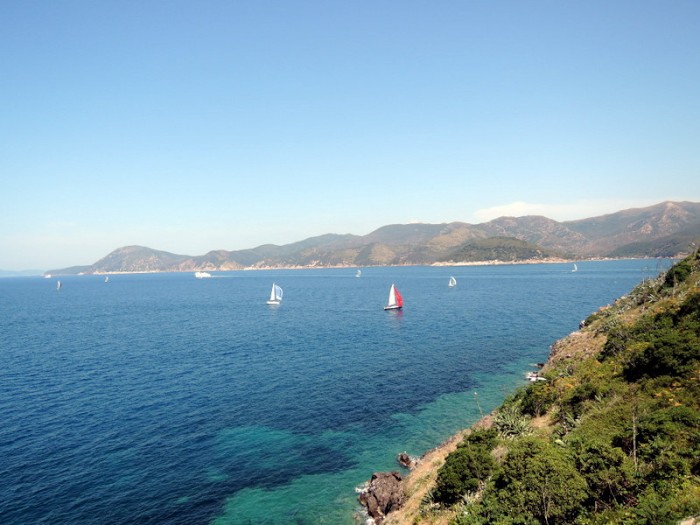
Grateful was I ere I saw Elba.
OK, I've ruined the palindrome* (Able was I ere I saw Elba) but it's true. I was grateful for two reasons. First, I always feel grateful when we arrive in a port at the end of a difficult upwind journey. Second, we'd been intending to visit Elba since our first summer in the Mediterranean, and we'd finally managed it. Even though we were trying to make a fast passage to Genoa, we decided to stay for a couple of nights and have a look around.
For our first night, we dropped our anchor in a lovely cove called Barbarossa (English translation Red Beard) just around the corner from Porto Azzurro. The depths were around 50 feet, but fortunately there was enough swing room for us to put out lots of chain. With the anchor well set, we turned in early and slept for a very long time. The next morning, we moved the boat over to Porto Azzurro. Arriving just as numerous boats were leaving, we had no trouble finding space. This time, we were only in about 20 feet of water. The view of the town from the water was enchanting.

Porto Azzurro is a pretty little town, but exploring it didn't require a lot of time, so we decided to rent a motorcycle and drive across the island to see Portoferraio. The price of 45 euros for a part-day rental was the most we'd ever paid, and we hoped it would be worth it.
It's always fun to see an island from a motorcycle. The drive across the island was lovely, taking us past beautiful vineyards and fields of hay. Much of southern Italy is a toasted brown colour at this time of year, but we could already see that things are different in Tuscany. Elba was green and lush everywhere we looked. Porto Ferraio itself was a bustling and busy spot, resulting in some heart-in-throat moments on the motorcycle. Once the bike was parked, we were able to relax over lunch in a café on the pretty waterfront. The food was delicious and the bill came with a beautifully coloured scallop shell on top, which the waiter told me I could keep. Italians have such a great sense of style! After we settled our bill (naturally with a bigger tip than usual) we set off to explore the historic centre of the town.
The most famous episode in Elba's history was undoubtedly Napoleon's exile there in 1814-1815. Following the defeat of France by the Sixth Coalition (comprised of various European countries including Russia, Austria, Prussia, the United Kingdom and others) Napoleon was forced to abdicate the French throne. The deal allowed him to reside on Elba with sovereignty over the island and a substantial income. Napoleon's home of Villa dei Mulini is now open to the public as a museum. We decided to visit, but an accidental detour took us first to the nearby Star Fort.
The woman who was selling tickets from the Star Fort's guardhouse wasn't getting much business, and was obviously finding the time long. "What's the capital of Pakistan?" she asked, pointing to her crossword puzzle. Luckily for her, geography is one of the skipper's many strengths, and (doubly lucky) Islamabad has the same name in Italian and English.
The view from the ramparts of the fort was glorious. Below us, a sailing regatta was taking place.


The Villa dei Mulini was beautifully situated and lavishly decorated. Rick and I could have happily settled in here, but it was probably still a bit of a comedown for an Emperor.



Among the most interesting items were Napoleon's camp bed (so tiny!!!) and a gown belonging to his sister Pauline, who kindly moved to Eba with him when his wife would not. Pauline by the way, was immortalized by Canova in a reclining sculpture called "Venus Victrix", now in the Galleria Borghese in Rome. Go to see it if you get the chance.


Travel writers often ask why why Napoleon would have wanted to escape from such a beautiful place, but Elba must have been a pretty small pond for such a big fish. I imagine he would have been scheming to get out of there from the minute he arrived. The bigger question is why he was permitted to bring his own warship with him, which gave him the means to escape from Elba after only 10 months. He sailed to Golfe-Juan and from there easily made his way to Paris, where he reclaimed his throne. As everyone knows, he met his Waterloo shortly thereafter, and was then exiled to the island of Saint Helena, which presumably was a bit more difficult to escape from. He died there in 1821 at only 51 years of age.
Returning to the waterfront, we climbed back onto the motorcycle and plunged back into the traffic. We had intended to explore a bit more of the island, but the sight of a serious motorcycle accident outside Portoferraio made us think twice. Instead, we made a short stop at a roadside stall to taste some Elban wine and olive oil. We were back in Porto Azzurro on time for late afternoon drinks and snacks on the waterfront. By this time, the anchorage was crammed with boats, and we were glad we'd arrived early.
Early the next morning, we lifted the anchor for our passage to Genoa. Sailing down the coast past Rio Marina, we saw the red earth that is evidence of Elba's now-defunct iron ore mining industry.

The journey to Genoa took only 22 hours, but it seemed much longer. With high winds from behind and very rough seas, I found it difficult to manage the sails alone at night, and Rick got only a few hours of sleep. We were both very tired when we arrived in Genoa at dawn the next day. It wasn't until later that it occurred to us that we'd just finished our last Mediterranean passage on Aisling. But long naps and a walk through the amazing historic centre of Genoa raised our spirits immensely. I think we're going to like it here!

*In case you were wondering, a palindrome is a word, phrase or sentence that reads the same forward or backward. Another famous example is "Madam I'm Adam".
OK, I've ruined the palindrome* (Able was I ere I saw Elba) but it's true. I was grateful for two reasons. First, I always feel grateful when we arrive in a port at the end of a difficult upwind journey. Second, we'd been intending to visit Elba since our first summer in the Mediterranean, and we'd finally managed it. Even though we were trying to make a fast passage to Genoa, we decided to stay for a couple of nights and have a look around.
For our first night, we dropped our anchor in a lovely cove called Barbarossa (English translation Red Beard) just around the corner from Porto Azzurro. The depths were around 50 feet, but fortunately there was enough swing room for us to put out lots of chain. With the anchor well set, we turned in early and slept for a very long time. The next morning, we moved the boat over to Porto Azzurro. Arriving just as numerous boats were leaving, we had no trouble finding space. This time, we were only in about 20 feet of water. The view of the town from the water was enchanting.
Porto Azzurro is a pretty little town, but exploring it didn't require a lot of time, so we decided to rent a motorcycle and drive across the island to see Portoferraio. The price of 45 euros for a part-day rental was the most we'd ever paid, and we hoped it would be worth it.
It's always fun to see an island from a motorcycle. The drive across the island was lovely, taking us past beautiful vineyards and fields of hay. Much of southern Italy is a toasted brown colour at this time of year, but we could already see that things are different in Tuscany. Elba was green and lush everywhere we looked. Porto Ferraio itself was a bustling and busy spot, resulting in some heart-in-throat moments on the motorcycle. Once the bike was parked, we were able to relax over lunch in a café on the pretty waterfront. The food was delicious and the bill came with a beautifully coloured scallop shell on top, which the waiter told me I could keep. Italians have such a great sense of style! After we settled our bill (naturally with a bigger tip than usual) we set off to explore the historic centre of the town.
The most famous episode in Elba's history was undoubtedly Napoleon's exile there in 1814-1815. Following the defeat of France by the Sixth Coalition (comprised of various European countries including Russia, Austria, Prussia, the United Kingdom and others) Napoleon was forced to abdicate the French throne. The deal allowed him to reside on Elba with sovereignty over the island and a substantial income. Napoleon's home of Villa dei Mulini is now open to the public as a museum. We decided to visit, but an accidental detour took us first to the nearby Star Fort.
The woman who was selling tickets from the Star Fort's guardhouse wasn't getting much business, and was obviously finding the time long. "What's the capital of Pakistan?" she asked, pointing to her crossword puzzle. Luckily for her, geography is one of the skipper's many strengths, and (doubly lucky) Islamabad has the same name in Italian and English.
The view from the ramparts of the fort was glorious. Below us, a sailing regatta was taking place.
The Villa dei Mulini was beautifully situated and lavishly decorated. Rick and I could have happily settled in here, but it was probably still a bit of a comedown for an Emperor.
Among the most interesting items were Napoleon's camp bed (so tiny!!!) and a gown belonging to his sister Pauline, who kindly moved to Eba with him when his wife would not. Pauline by the way, was immortalized by Canova in a reclining sculpture called "Venus Victrix", now in the Galleria Borghese in Rome. Go to see it if you get the chance.
Travel writers often ask why why Napoleon would have wanted to escape from such a beautiful place, but Elba must have been a pretty small pond for such a big fish. I imagine he would have been scheming to get out of there from the minute he arrived. The bigger question is why he was permitted to bring his own warship with him, which gave him the means to escape from Elba after only 10 months. He sailed to Golfe-Juan and from there easily made his way to Paris, where he reclaimed his throne. As everyone knows, he met his Waterloo shortly thereafter, and was then exiled to the island of Saint Helena, which presumably was a bit more difficult to escape from. He died there in 1821 at only 51 years of age.
Returning to the waterfront, we climbed back onto the motorcycle and plunged back into the traffic. We had intended to explore a bit more of the island, but the sight of a serious motorcycle accident outside Portoferraio made us think twice. Instead, we made a short stop at a roadside stall to taste some Elban wine and olive oil. We were back in Porto Azzurro on time for late afternoon drinks and snacks on the waterfront. By this time, the anchorage was crammed with boats, and we were glad we'd arrived early.
Early the next morning, we lifted the anchor for our passage to Genoa. Sailing down the coast past Rio Marina, we saw the red earth that is evidence of Elba's now-defunct iron ore mining industry.
The journey to Genoa took only 22 hours, but it seemed much longer. With high winds from behind and very rough seas, I found it difficult to manage the sails alone at night, and Rick got only a few hours of sleep. We were both very tired when we arrived in Genoa at dawn the next day. It wasn't until later that it occurred to us that we'd just finished our last Mediterranean passage on Aisling. But long naps and a walk through the amazing historic centre of Genoa raised our spirits immensely. I think we're going to like it here!
*In case you were wondering, a palindrome is a word, phrase or sentence that reads the same forward or backward. Another famous example is "Madam I'm Adam".
Porto Ercole
02 July 2016 | Genoa
Bonnie
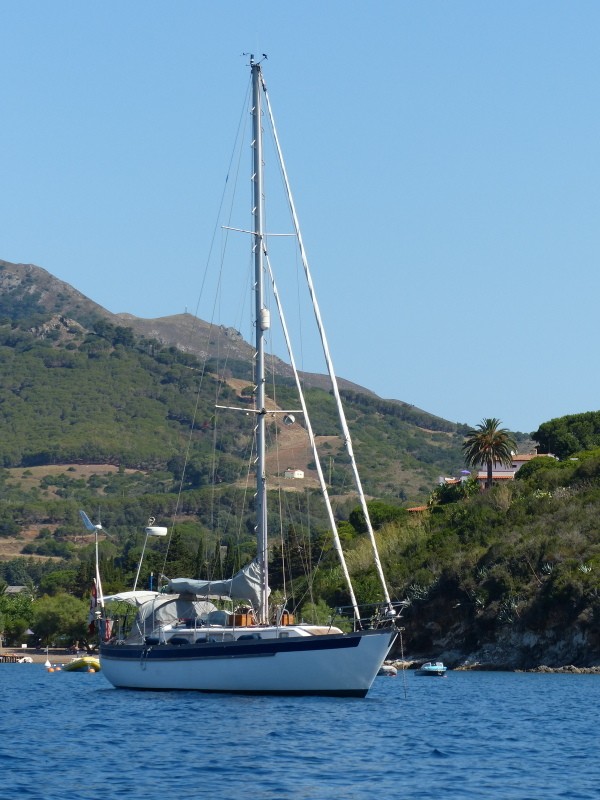
It just occurred to me that we gave Porto Ercole rather short shrift in the last blog posting. There were good reasons for that: our stop there was brief, and we really didn't explore it properly.
In addition to the fact that sailing into a 20 knot headwind and short choppy waves was getting less appealing by the minute, Rick's motivation for stopping in Porto Ercole had been an old Globe and Mail article about an exclusive resort called Il Pellicano. The main building at Il Pellicano had originally been built as a retreat by a California heiress and her lover, a brave British airman who survived after jumping out of a plane without a parachute (yes). The article spoke of the "ruggedly beautiful" Tyrrhenian coastline, a "rocky, pine-covered peninsula" and ruins of Roman villas nearby. It spoke of forts built by the Medici and Spaniards. But mainly, it described Il Pellicano, a shockingly expensive resort where the patrons arrive in shockingly expensive cars and sleep in shockingly expensive rooms in private cottages. They can take an elevator to the sun deck and bathing platform on the cliff face, or admire the view from the heated saltwater swimming pool. At night, they can eat at the Michelin-starred restaurant. The amenities at Il Pellicano were not the least bit relevant to us, because a quick check of Trip Advisor showed prices that ranged from 670 to 2500 euros for a single night. If you hear that we've booked in there, please rush us to the nearest emergency room to have our heads examined. As it was, we balked at the 90 euro fee for one night at the marina, and stayed at anchor instead. As Rick put it "I guess if someone offered me 90 euros to put a dinghy in the water, I'd probably do it." Besides, being at anchor is nicer.
On the other hand, really nice hotels tend to be located in really beautiful places, which was Rick's logic for sailing into Porto Ercole. And indeed it was a gorgeous place, with a star-shaped fort (Forte Stella) looming over the water on one side and the Spanish Forte la Rocca on the other. In fact there seem to be four forts in the vicinity. All of this, combined with a backdrop of mountains, forests and an incredibly blue Tyrrhenian sea, make the views from land and water quite stunning. On the way in, Rick scanned the hills with his binoculars. "I think I see Il Pellicano!" he said. Maybe. In any case, after a long passage, nothing beats gazing at such a beautiful view while enjoying a delicious seafood lunch with a cold beer. Peroni Riserva, no less. If you happen to be in the area, we highly recommend Il Gambero Rosso.
Aside from the fact that Porto Ercole is located near the island of Giglio, where the ill-fated Costa Concordia went aground, there was one other important piece of history that we forgot to mention. Porto Ercole is generally accepted to be the place where Michelangelo Merisi, the painter known as Caravaggio, died in 1610. The circumstances of his death are still disputed, but it is believed that he died there of a fever while rushing to Rome, where he was hoping to receive a pardon for killing a man in a brawl four years previously. A tragic end to a sad life. In any case, even though we hadn't thought about it at the time, a stop in Porto Ercole was very fitting for two diehard Caravaggio fans. We didn't see his tomb though. Maybe we'll have to go back. There's gotta be at least one nice hotel in Porto Ercole, right?
In addition to the fact that sailing into a 20 knot headwind and short choppy waves was getting less appealing by the minute, Rick's motivation for stopping in Porto Ercole had been an old Globe and Mail article about an exclusive resort called Il Pellicano. The main building at Il Pellicano had originally been built as a retreat by a California heiress and her lover, a brave British airman who survived after jumping out of a plane without a parachute (yes). The article spoke of the "ruggedly beautiful" Tyrrhenian coastline, a "rocky, pine-covered peninsula" and ruins of Roman villas nearby. It spoke of forts built by the Medici and Spaniards. But mainly, it described Il Pellicano, a shockingly expensive resort where the patrons arrive in shockingly expensive cars and sleep in shockingly expensive rooms in private cottages. They can take an elevator to the sun deck and bathing platform on the cliff face, or admire the view from the heated saltwater swimming pool. At night, they can eat at the Michelin-starred restaurant. The amenities at Il Pellicano were not the least bit relevant to us, because a quick check of Trip Advisor showed prices that ranged from 670 to 2500 euros for a single night. If you hear that we've booked in there, please rush us to the nearest emergency room to have our heads examined. As it was, we balked at the 90 euro fee for one night at the marina, and stayed at anchor instead. As Rick put it "I guess if someone offered me 90 euros to put a dinghy in the water, I'd probably do it." Besides, being at anchor is nicer.
On the other hand, really nice hotels tend to be located in really beautiful places, which was Rick's logic for sailing into Porto Ercole. And indeed it was a gorgeous place, with a star-shaped fort (Forte Stella) looming over the water on one side and the Spanish Forte la Rocca on the other. In fact there seem to be four forts in the vicinity. All of this, combined with a backdrop of mountains, forests and an incredibly blue Tyrrhenian sea, make the views from land and water quite stunning. On the way in, Rick scanned the hills with his binoculars. "I think I see Il Pellicano!" he said. Maybe. In any case, after a long passage, nothing beats gazing at such a beautiful view while enjoying a delicious seafood lunch with a cold beer. Peroni Riserva, no less. If you happen to be in the area, we highly recommend Il Gambero Rosso.
Aside from the fact that Porto Ercole is located near the island of Giglio, where the ill-fated Costa Concordia went aground, there was one other important piece of history that we forgot to mention. Porto Ercole is generally accepted to be the place where Michelangelo Merisi, the painter known as Caravaggio, died in 1610. The circumstances of his death are still disputed, but it is believed that he died there of a fever while rushing to Rome, where he was hoping to receive a pardon for killing a man in a brawl four years previously. A tragic end to a sad life. In any case, even though we hadn't thought about it at the time, a stop in Porto Ercole was very fitting for two diehard Caravaggio fans. We didn't see his tomb though. Maybe we'll have to go back. There's gotta be at least one nice hotel in Porto Ercole, right?
| Vessel Name: | Aisling I |
| Vessel Make/Model: | Slocum 43 |
| Hailing Port: | Halifax, NS, Canada |
| Crew: | Rick and Bonnie Salsman |
| About: | |
| Extra: | |
| Social: |
About Aisling 1
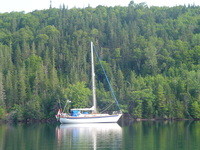
Who: Rick and Bonnie Salsman
Port: Halifax, NS, Canada
Quick Links
- Miscellaneous
- Greece-other
- Croatia and Montenegro 2012
- Sicily 2011-2014
- Italy (Mainland) 2012
- Weather and Technical
- Turkey
- Greece-Aegean
- Syracuse 2009
- Tunisia
- Malta
- Greece Ionian & Gulf of Corinth
- Sicily 2008
- Corsica and Sardinia
- Southern France
- Transatlantic part 2-Azores to Baiona
- Azores 2007
- South Spain & Balearics-2008
- South Spain & Gibraltar 2007
- Portugal 2007
- Atlantic Spain
- Transatlantic part 1-Halifax to Azores
- Previous Trips
- pre departure
- Show All Posts

